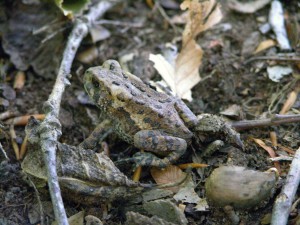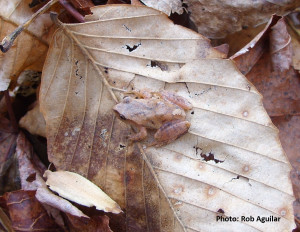by Heather Soulen
Sonic Cacophonies

American Toad (Photo: Tyler Bell)
It’s that time of year when much of the mid-Atlantic is waking up from a long winter’s slumber. Flowers are blooming, trees are budding, ospreys and eagles are nesting, and frogs are calling. Right now, the Smithsonian Environmental Research Center (SERC) is alive with the sonic cacophony of a two amphibians. Spring peepers (Pseudacris crucifer) and American toads (Anaxyrus americanus, formerly Bufo americanus) are shouting mating anthems from every available pocket of water. If you live east of the Mississippi River from Canada to Florida, you’ve likely heard their calls. But which is which? We’ve collected a few sound bites around SERC to help identify each amphibian’s call.
In the clip below, you’ll hear the short high-pitched chirping or whistling sounds of spring peepers and the slightly deeper, long drawn trill sounds of American toads.
In this clip, you’ll hear the same short high-pitched chirping or whistling sounds of spring peepers and slightly deeper, long drawn trill sounds of American toads. However, if you listen closely, you’ll also hear several high-pitched trill sounds that increase in pitch over the one to two second frog call. This call is a warning or alert call by spring peepers. Males emit this sound when another male has entered its territory or mistaken it for a female during an amplexus attempt. You can hear examples of this alert call near the 10 second mark through the 25 second mark.
There’s Mystery in These Woods: A Congregation

Spring Peeper (Photo: Rob Aguilar)
Spring peepers and American toads are typically found in moist wooded areas, fields and grassy lowland areas near breeding ponds and wetlands. While mostly terrestrial, they are normally found under logs, rocks and other objects. However, during times of breeding they are found in and around ephemeral (temporary) or permanent bodies of water with plants, sticks and other debris. In spring, males congregate near these types of water bodies and begin singing to attract a mate. Spring peepers make short high-pitched chirping or whistling sounds while American toads make slightly deeper, long drawn trill sounds. Females can lay close to 1,000 eggs that are attached to submerged aquatic vegetation (SAV) and other substrates within fish free water bodies to reduce egg predation. Males fertilized the eggs as they are laid. Eggs can hatch within two days to two weeks depending on temperature. We were lucky to catch the American toad calls since they have a quite narrow breeding window, often only lasting a mere few days in spring.

